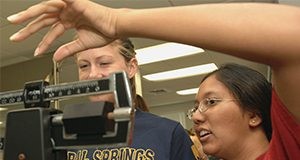Resumen
This EDIS document is the second in a series discussing how Extension can more efficiently encourage citizens to join the local food movement by effectively utilizing and leveraging opinion leaders. These articles look at the role opinion leaders, or individuals who have a large amount of influence within their respective social circles, can have on motivating their peers to join in purchasing local food. Written by Layne S. Marshall, Melissa R. Taylor, and Alexa J. Lamm, and published by the UF Department of Agricultural Education and Communication, August 2016.
Citas
DeWeerdt, S. (2011). Is Local Food Better? The World Watch Institute, 22(3). Retrieved from http://www.worldwatch.org/node/6064
Dunning, R. (2013). Research-Based Support and Extension Outreach for Local Food Systems. Center for Environmental Farming Systems. Retrieved from http://www.cefs.ncsu.edu/resources/guides/research-based-support-for-local-food-systems.pdf
Draper, A., & Green, J. (2002). Food safety and consumers: constructions of choice and risk. Social Policy & Administration, 36(6), pp. 610-625. https://doi.org/10.1111/1467-9515.00307
Edwards, G.J., Canals, L. M., Hounsome, N., Truninger, M., Koerber, G., Hounsome, B., ... Jones, D. L. (2008). Testing the assertion that 'local food is best': The challenges of an evidence-based approach. Trends in Food Science & Technology 19(5), 265-274. doi:10.1016/j.tifs.2008.01.008. Received from http://www.sciencedirect.com/science/article/pii/S0924224408000034 https://doi.org/10.1016/j.tifs.2008.01.008
Grubinger, V. (2004). Why buy local: 10 reasons to buy local food. Reprinted from With an Ear to the Ground. Northeast Region SARE. Retrieved from http://www.grownyc.org/greenmarket/ourmarkets/whylocal
Hunt, A. (2007). Consumer interactions and influences on farmers market vendors. Renewable Agriculture and Food Systems 22(1), 54-66. https://doi.org/10.1017/S1742170507001597
Litt, J.S., Soobader, M.J., Turbin, M. S., Hale, J. W., Buchenau, M., & Marshall, J. (2011). The influence of social involvement, neighborhood aesthetics, and community garden participation on fruit and vegetable consumption. American Public Health Association, 101(8), 1466-1473. https://doi.org/10.2105/AJPH.2010.300111
Low, S. A., Adalja, A., Beaulieu, E., Key, N., Martinez, S., Melton, A., ... Jablonski, B. R. (2015). Trends in US local and regional food systems: A report to Congress. AP-068, United States Department of Agriculture, Economic Research Service. Retrieved from http://www.ers.usda.gov/media/1763057/ap068.pdf
Macias, T. (2008). Working toward a just, equitable, and local food system: The social impact of community- based agriculture. Social Science Quarterly 89(5), 1086-1101. doi: 10.1111/j.1540-6237.2008.00566.x https://doi.org/10.1111/j.1540-6237.2008.00566.x
Nisbet, M. C., & Kotcher, J. E. (2009). A two- step flow of influence: Opinion- leader campaigns on climate change. Science Communication, 30(3), 328-354. doi: 10.1177/1075547008328797 https://doi.org/10.1177/1075547008328797
Onozaka, Y., Nurse, G., & McFadden, D. T. (2010). Local food consumers: How motivations and perceptions translate to buying behavior. Choices: Agricultural & Applied Economics Association 25(1). Retrieved from http://www.choicesmagazine.org/magazine/article.php?article=109#sthash.Psyq5fki.dpuf
Role of community gardens in sustaining healthy communities. (2010). Designing Healthy Communities. Retrieved from http://designinghealthycommunities.org/role-community-gardens-sustaining-healthy-communities/
Roper, C. G., & Rumble, J. N. (2014). Talking local: Florida consumers' reasons for purchasing local food. Gainesville: University of Florida Institute of Food and Agricultural SciencesRetrieved from http://edis.ifas.ufl.edu/wc176
Ruehle, J., & Goldblatt, M. (2013). National retailers need to get smart about local groceries: Buying into the local food movement. ATKearney. Retrieved from https://www.fmi.org/docs/default-source/webinars/perspectiveon-marketdynamics.pdf?sfvrsn=2
Saldivar-tanaka, L., & Krasny, M. E. (2004). Culturing community development, neighborhood open space, and civic agriculture: The case of Latino community gardens in New York City. Agriculture and Human Values, 21, 399-412. https://doi.org/10.1023/B:AHUM.0000047207.57128.a5
Salois, M. (2011). Obesity and diabetes, the built environment, and the local food economy in the United States. Economics and Human Biology, 10(1), 35-42. doi: 10.1016/j.ehb.2011.04.001. https://doi.org/10.1016/j.ehb.2011.04.001
Sommer, R., Herrick, J., & Sommer, T. R. (1981). The Behavioral Ecology of Supermarkets and Farmers Markets. Journal of Environmental Psychology, 1(1), 13-19.
https://doi.org/10.1016/S0272-4944(81)80014-X
Thilmany, D., Bond, C. A., & Bond, J. K. (2008). Going Local: Exploring Consumer Behavior and Motivations for Direct Food Purchases. American Journal of Agricultural and Applied Economics, 5, 1303-1309. doi: 10.1111/j.1467-8276.2008.01221.x https://doi.org/10.1111/j.1467-8276.2008.01221.x
Valente, T. W. & Pumpuang, P. (2007). Identifying opinion leaders to promote behavior change. Health & Behavior, 34(6), 881-896. doi: 10.1177/1090198106297855 https://doi.org/10.1177/1090198106297855

